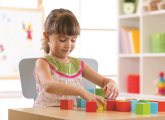A treasure-filled island is the perfect spot to develop children’s understanding of the world. Try these EYFS pirate activities from Judith Harries…
Helping children to understand the world around them is a key part of learning in every early years setting. Use these activities to encourage the children in your care to follow their instinctive, natural curiosity about the world and become ‘investigators’ as they discover more about materials, forces, sound, changing state, magnetism and the natural world.
Each group of activities is introduced with an imaginative story, challenge or book to set off the investigation…
Introduce these activities by reading The Treasure Hunt by Nick Butterworth, The Night Pirates by Peter Harris or a pirate story of your choice. Explain that the children are going to look at some different treasures…
Cover a cardboard box on each of its six sides with different textured materials, such as velvet, shiny paper, corrugated cardboard, sandpaper, wool, faux fur or lace.
Encourage children to touch the different sides and watch how they respond. Is there a favourite material that they choose to touch more frequently?
Cut a round hole into one side of the box so children can put one hand inside. Place different items in the box for children to touch and discover.
Try a tennis ball, pine cone, orange, smooth stone, shaky egg, shiny medal, and so on. Photograph or film their reactions to the treasures inside.
Collect some cardboard six-segment egg boxes with lids. Let children paint these with bright colours. Put six different items into each box, one in each segment, for children to discover, place and sort.
Use a selection of materials, for example, a wooden brick, ball, feather, stone, small sponge, key, plastic duck, candle, dried flower, chocolate coin.
Encourage children to open the egg box and handle each of the six items inside. Talk about different materials, objects, textures, etc. What are each of the items made of? Can they put the items back into the box, one in each segment?
Use the egg boxes as treasure boxes again, but this time group objects according to different criteria.
Make a box of reflective materials – old CD, shiny ribbon, aluminium foil, small mirror, key, glass bead; wood/natural materials – wooden brick, bark, twig, shell, leaf, feather, pebble; textiles – net, velvet, lace, wool, nylon, fun fur, felt, leather, cotton, plastic.
Jumble up all the contents together. Can the children sort them into the special treasure boxes? Let children use a magnifying glass to look closely at some of their treasures.
Choose a selection of treasures to use in a treasure hunt. Hide them around the setting, inside or outside, and leave clues for the children to follow. Place a final treasure chest full of chocolate coins to share at the end.
Tell the children that they have been asked to help some pirates move their treasure to a better hiding place so need to improve their rowing and moving skills…
Sit in a circle with a small group of children and adults holding on to a loop of stretchy rope. Help children to hold the rope in front of them so it is taut.
Invite all to move their hands in and out as though rowing, and chant “In, out, push, pull” as you row together.
Ask children to sit opposite a partner and sing ‘Row, row, row your boat’ as they row to and fro. Point out that it will only work if one child is pulling, while the other is pushing.
Can they row to Treasure Island and pick up a chest of treasures for the pirates? Where would be a good place to hide the treasure?
They need to move the treasure somewhere really safe, but it’s too precious to be touched by their hands. Let children investigate what happens when they blow and suck through a straw.
Can they push and pull the air and use their breath to pick up different items or treasures? Provide a collection of items such as raisins, marbles, beads, balloons, feathers, small plastic toys, Maltesers, balls, etc., and two small baskets.
Can they suck on the straw and use their breath to move the different items from one place to another to help the pirates? Why are some things easier to move than others?
On the treasure island there are lots of strange noises to be heard. But how do the sounds reach our ears?
Sit a group of children around a large low gathering drum. Invite children to tap the drum gently. How does it make a sound?
Place some small plastic frogs or bugs on the skin of the drum. Ask the children what they think will happen to the bugs when they tap the drum. Do they think the bugs will stay still or move? Pretend that these are the bugs from the island.
Try tapping the drum together and watch the bugs bounce up and down. Explain that the skin of the drum wobbles (vibrates) when tapped and this makes the bugs bounce.
Use a snare drum or empty biscuit tin and a pair of drumsticks. Tap the drum. Can the children hear the sound? How does it make a sound?
Explain that the drumskin is moving or vibrating. Can the children see the drumskin moving? Place a few grains of dry rice on the drum and tap it again. What did the children see happen? Video the rice flying in the air.
Talk about how the sound of a drum or voice travels through the air by creating vibrations or sound waves. Explain that these cannot normally be seen.
Record the children’s voices using a simple program such as Audacity. Look at the sound wave created by the children saying their names into the microphone. What do the children notice about its shape? When the sound is loud/quiet, what happens to the wave?
Ask the children to make some sounds using their voices. Use the ‘Change speed’ effect to speed up the voices and make them sound like birds or insects. These may be the sounds of the bugs on the treasure island.
The only edible plant growing on the treasure island is oats and the only animals are cows. Show children some oat plants. What can they make for the pirates to eat?
Explain that you are going to make some porridge and ask the children what ingredients will be needed. Look at the porridge oats, milk, water and talk about the difference between solids and liquids.
What do children think will happen when they mix the oats into the milk and water? Let them investigate with bowls and spoons in the water tray.
What else do they need to do to turn the mixture into porridge? Let them watch as you heat up the mixture, stirring all the time, and allow the porridge to simmer for four minutes. Serve with different toppings.
Let younger children explore the sights of the ocean surrounding the island, while the older children use investigative skills to help the pirates find out if anyone has been trying to reach their treasure…
Place glass pebbles, small plastic fish or sea creatures, and shells inside a large plastic bottle. Fill three-quarters with cold water coloured with blue food colouring, and then add a bottle of baby oil.
Seal the bottle securely. Lie it on its side and invite children to watch the sea creatures moving in the ocean. The oil and water don’t mix and bubbles should form in the oil.
Let children look at their fingerprints. Explain that everybody has unique fingerprints and sometimes they are used to identify people.
Let children look at their fingerprints using magnifying glasses or a visualiser. Show them how to press their thumb onto an ink pad and then carefully print it onto an ID card. Examine the prints carefully and see if the children can see arches, whorls or loops.
Alternatively, press the fingerprints onto a flat balloon. Then blow up the balloon a little so they are enlarged and easier to see.
Can they see any fingerprints on the pirates’ treasure? Try pressing fingers onto a clear plastic surface. Dust it with cocoa powder and then brush off any excess. Place a strip of sticky tape on top of the powder and lift off any print. Stick onto a piece of white paper to examine the prints.
Provide children with a hand-held digital microscope and allow them to investigate how it works. Make a box of suitable items for them to look at using the microscope, including items of treasure (see Investigating materials above), feathers, grass, leaves, stones, bark, etc.
Can they use the microscope to look at their own fingerprints close up?
Can the children test the pirate’s treasure to find out if it is magnetic? All the most valuable treasure will stick to a magnet...
Make a collection of small items that you know are magnetic: screws, paperclips, staples, metal ball bearings, picture hooks, coins, etc.
Make a collection of non-magnetic items such as buttons, plastic sorting toys, beads, foam shapes, paper stars, chocolate coins, etc.
Place a variety of both magnetic and non-magnetic items inside a plastic bottle with a wide opening, along with some sand or dry rice. Glue the lid on carefully.
Provide the children with a magnetic wand or small magnet and ask them to slide it along the bottle. What happens? Why do some items stick to the wand whilst others don’t? Use the investigation to introduce the idea of magnets.
Follow the discovery bottle activity by asking children to sort a similar mixture of small items into two sets or hoops – those they think will stick to a magnet and those that won’t.
Test the predictions by using a magnet. What do all the magnetic items have in common? Which pieces of the pirate’s treasure are magnetic?
The pirates have heard there are some very poisonous caterpillars on the island. They want to place them on plants nearby to guard their treasure. How will they find them?
Cut 2cm lengths of wool using some bright colours such as red, yellow and orange, and some brown, green and grey.
Go outside and place these woolly caterpillars on a selection of plants, flowers and bushes. Send the children out in small groups to collect as many caterpillars as they can.
The first group will most likely return with all the brightly coloured caterpillars. Subsequent groups will find the brown, green and grey ones.
Why do the children think this happened? Why is it important for the caterpillars to be harder to find. Introduce the idea of camouflage.
Go outside and hunt carefully for real caterpillars. Talk about where they might be hiding, on the underside of leaves, under flowers, etc. Are they easy to find? Talk about camouflage as above.
When some have been found, adults should put them inside a magnifying box so children can observe them more closely.
Provide leaves for the caterpillars to eat. Invite children to sketch the caterpillars. Talk about the life cycle of the caterpillar.
Look out for pupae or butterflies in the outside area. Photograph the caterpillars before releasing them back into the garden.
Judith Harries is an author and teacher of music and drama, with experience of working with children aged nine months to 11 years.

Observations – using a strengths-based approach
Editors picks

Child led learning – Ideas to try in Early Years
Editors picks
